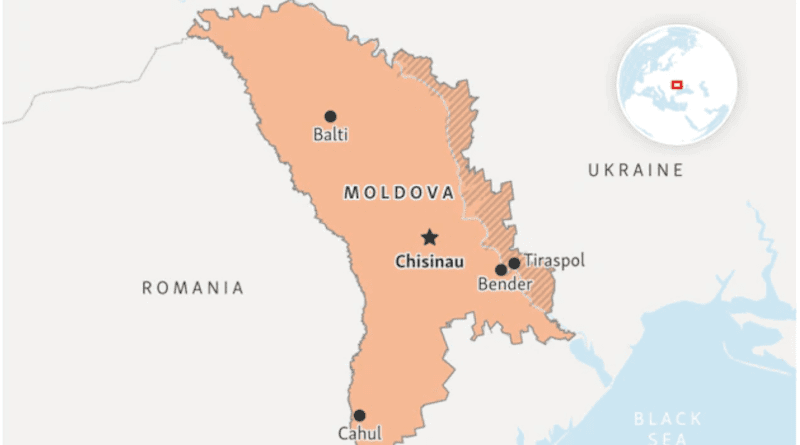Moldova May Become Russia’s Next Target – OpEd
By Arab News
By Yasar Yakis*
After South Ossetia, Crimea and Ukraine, Russia may now be coveting two Eastern European territories, Moldova and Transnistria. Russia’s interest in Moldova had already become manifest when it proclaimed Transnistria, a disputed area in the east of the country, an independent state. The Russian army has deployed 1,500 soldiers in a military base in Transnistria, qualifying them as peacekeepers. Few countries paid attention to this move.
The UN does not recognize Transnistria as an independent state, while the Parliamentary Assembly of the Council of Europe last year identified Transnistria as a Moldovan territory occupied by Russia.
Moldova’s efforts to gain independence go back more than a century. In 1812, Moldova, then known as Moldavia, was ceded to Russia by the Ottoman state. In the 1850s, it became part of Romania. Russia recaptured the Moldovan territories in 1878. In 1917, Moldova, then Bessarabia, became an autonomous state within the Russian Republic. It proclaimed its independence the following year, but shortly afterward it agreed to join Romania. Russia contested this move and in 1924 it established the Moldavian Autonomous Soviet Socialist Republic within the Ukrainian Soviet Socialist Republic.
The Soviet Union had wanted for a long time to incorporate Bessarabia, which constituted most of present-day Moldova. It carried out this plan in 1940 with a pact signed by the Soviet and German foreign ministers, Vyacheslav Molotov and Joachim von Ribbentrop. The pact allowed the Soviets to annex part of the Romanian territory of Bessarabia to Moldova. We may presume that Russia had a long-term strategy to gain a foothold in the area and explore future opportunities if and when they arose.
Russia may consider Transnistria and Moldova as a deal in two steps. In the first step, Moscow may further promote Transnistria, which has a population of less than 1 million, as an independent state, even though its diplomatic recognition is very low at present. If new countries recognize Transnistria’s statehood, Russia may take additional steps in order to secure its recognition by the UN. This is part of continuity in Russia’s state memory.
Ironically, the Azerbaijani autonomous region of Nagorno-Karabakh, which is not recognized either by Russia or Armenia (and which the Armenians call Artsakh), has recognized Transnistria as an independent state. The two other countries that have recognized Transnistria are Abkhazia and South Ossetia.
The next step after this may be to shake the foundations of the state of Moldova, as the latter has common structures with Transnistria. Russia has already cut off most of its natural gas supply to Europe, including Moldova, claiming maintenance and payment issues. Moldovan authorities also complain about Russia’s violations of its airspace.
This geographical region of Eastern Europe has a very complex ethnic composition. Russia has always claimed that Russian-speaking Transnistrians were being oppressed. Moldova’s pro-Western Prime Minister Natalia Gavrilita this month handed in her resignation after the violation of her country’s airspace by Russia.
During the dismemberment of the Soviet Union in 1991, many observers thought that no serious threat was directed at Transnistria because, for Russia to intervene in this unrecognized territory, it would have to first cross vast Ukrainian lands. This assessment turned out to be wrong. On April 22 last year, Russian Gen. Rustam Minnekayev threatened that the Russian control over southern Ukraine would open the route to Transnistria, which means that Russia is now threatening both Ukraine and the faraway Transnistria, as well as, eventually, the Republic of Moldova.
During the dissolution of the Soviet Union, Moldova acted quickly, declaring its independence and becoming a member of major Western European organizations, including the Council of Europe, the Organization for Security and Cooperation in Europe, and the Black Sea Economic Cooperation. It has also become a member of the Russia-dominated Commonwealth of Independent States. Moscow is now trying to disengage both Transnistria and Moldova from the European structures.
Turkiye is closely interested in Moldova because there is a Turkish-speaking autonomous region within the country. It is called Gagauzia, which is inhabited by a Turkic tribe from Central Asia. The Byzantine archives mention that Oghuz tribes, from the 11th century on, settled in Macedonia, Greece and Bulgaria. They were converted to the Orthodox sect of Christianity. The Gagauz, together with the Jewish Karaites living mostly in the Baltic state of Lithuania, are the only non-Muslim peoples who speak Turkish. Karaites are the descendants of the Turkish-speaking Khazar people, who adopted Judaism as their state religion in the early decades of the 10th century.
As a result of Gagauzia, Turkiye-Russia relations may soon face another reversal, but Turkish President Recep Tayyip Erdogan and Russian President Vladimir Putin may find common ground to ignore their disagreement on this subject. They have done it several times in the past. And they can do it now that the two leaders need each other’s support more than they needed it in the past.
• Yasar Yakis is a former foreign minister of Turkiye and founding member of the ruling AK Party.

